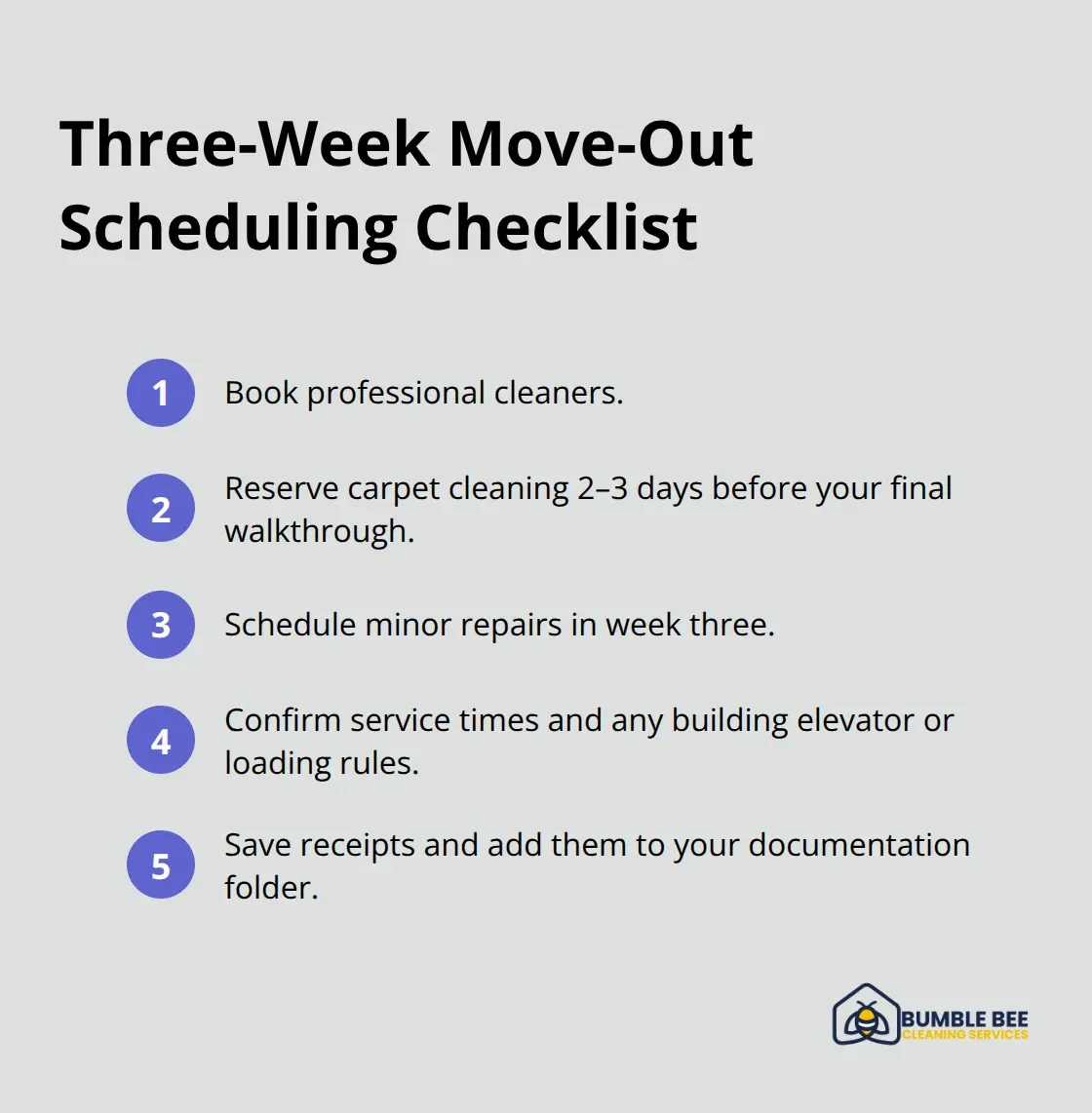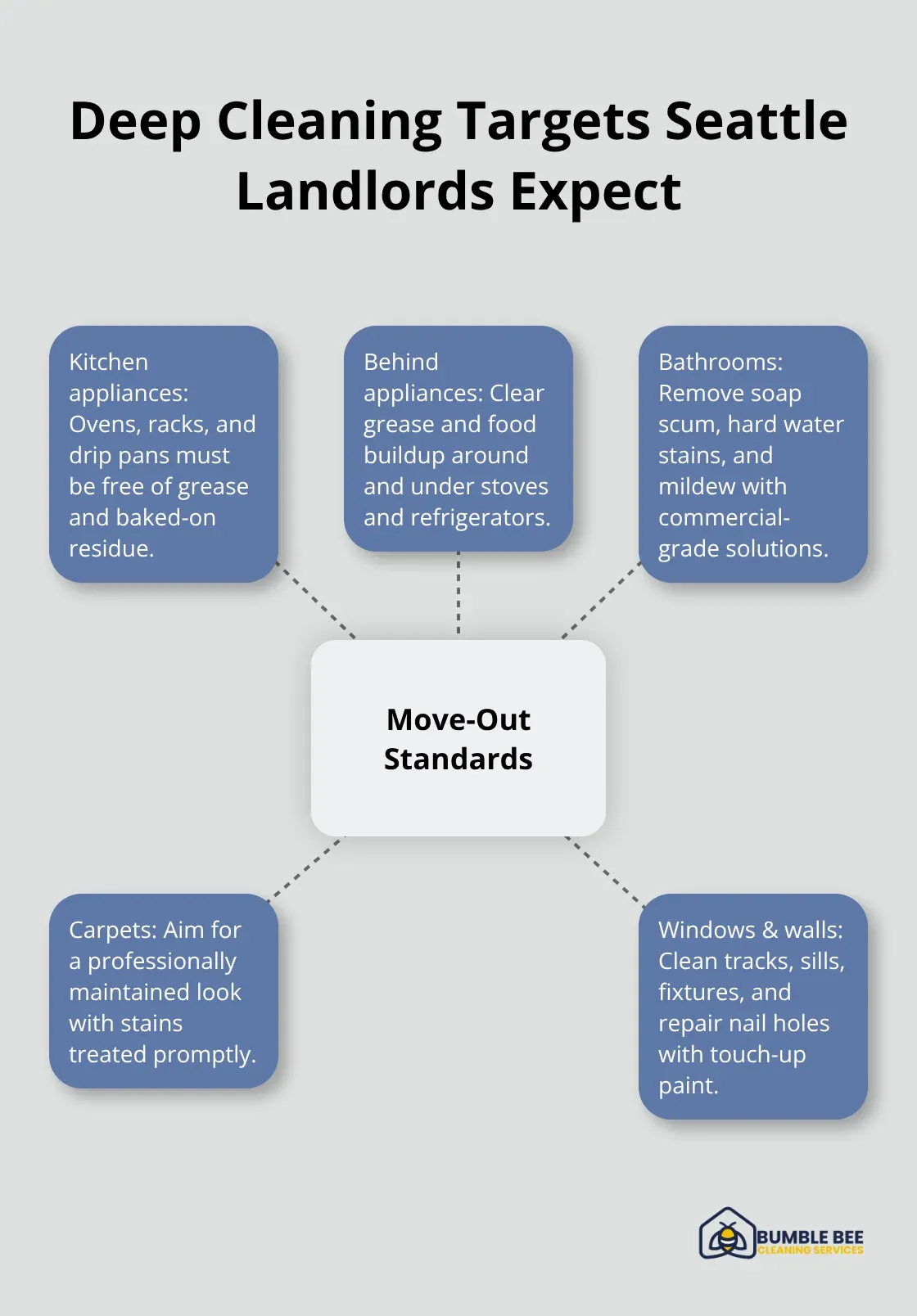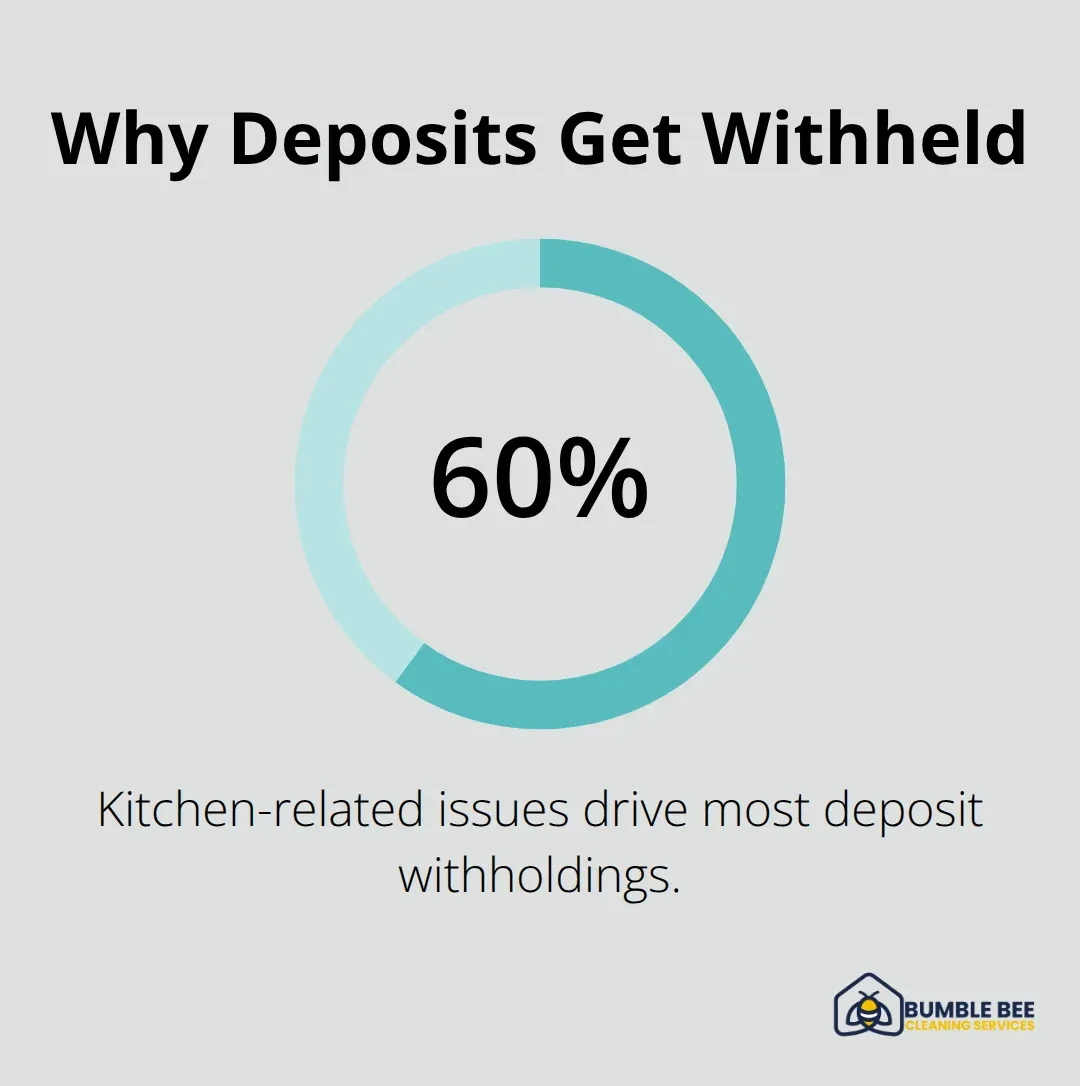Moving out of your Seattle rental doesn’t have to be stressful when you have the right move-out preparation strategy. Most renters lose part of their security deposit due to inadequate cleaning and missed lease requirements.
We at Bumble Bee Cleaning Services have helped hundreds of Seattle tenants get their full deposits back. This guide covers everything you need to know about deep cleaning standards, documentation, and timing to make your move-out seamless.
When Should You Start Move-Out Planning
You need to start your move-out process 30 days before your lease ends to handle everything without pressure. Poor preparation leads to deposit issues for many renters. Most Seattle renters who lose deposit money wait until the last week to begin their move-out tasks.
Review Your Lease Terms First
Your lease agreement contains specific move-out requirements that vary between properties. Washington State requires 20 days written notice, but many Seattle leases demand 30 days or more. Check for standards, carpet requirements, and repair obligations listed in your contract. Some landlords require professional receipts, while others accept tenant work if it meets their standards. Document these requirements immediately and add them to your timeline.
Book Professional Services Three Weeks Early
Professional services in Seattle get booked solid during peak months of summer and early fall (June through September). You should schedule your move-out work at least three weeks before your move date. The average move-out service for a two-bedroom Seattle apartment costs $300-400 and takes professionals 4-6 hours to complete. Carpet work should happen 2-3 days before your final walkthrough to allow proper drying time. Schedule any needed repairs during your third week to avoid conflicts with your timeline.

Create Your Documentation System Now
Start to photograph your rental condition immediately, focus on areas that typically cause deposit disputes like carpet stains, wall marks, and appliance condition. Take photos with timestamps and store them in a dedicated folder on your phone. Washington landlords have 30 days to return deposits or provide itemized damage lists. Your documentation becomes vital evidence if disputes arise over normal wear versus actual damage charges.
Now that you have your timeline and documentation system in place, you need to understand the specific standards that Seattle landlords expect for each area of your rental unit.
What Deep Cleaning Standards Do Seattle Landlords Expect
Seattle landlords maintain strict standards that go far beyond basic tidiness. Your oven must be spotless inside and out, including racks and drip pans that most tenants ignore. Grease buildup behind appliances costs renters an average of $150 in fees when landlords hire professionals after move-out.

Bathrooms require complete removal of soap scum, hard water stains, and mildew that Seattle’s humid climate creates year-round. Professional cleaners use commercial-grade solutions that household products cannot match for these tough stains.
Kitchen Areas Demand Professional-Level Results
Landlords expect ovens to shine like new units, with zero grease residue on interior surfaces, racks, or drip pans. Most tenants skip the area behind refrigerators and stoves, where grease and food particles accumulate over months. Range hoods collect sticky residue that requires degreasing agents stronger than standard household cleaners. Cabinet interiors need thorough wiping, especially around hinges and handles where fingerprints and food spills create buildup. Countertops must be free of stains, scratches from cutting, and water damage around sinks.
Carpet Work Determines Your Deposit Return
The Carpet and Rug Institute recommends daily vacuuming for high-traffic areas, which shows how much dirt accumulates in rental carpets over time. Seattle landlords expect carpets to look professionally maintained, not just surface-clean. Stains from coffee, wine, or pet accidents require immediate professional treatment to avoid permanent damage charges. Standard carpet work costs $149 for three rooms and takes 90 minutes when done by certified technicians. Hot water extraction removes deep dirt that regular vacuums miss, while chemical-free methods prevent residue buildup that attracts more dirt later.
Windows and Walls Need Thorough Attention
Light fixtures, baseboards, and window tracks collect dust that tenants overlook during regular maintenance. Nail holes from wall hangings must be filled and touched up with matching paint (or landlords will charge for full wall repainting). Window work includes frames, sills, and screens that accumulate Seattle’s seasonal pollen and urban grime. Wall marks from furniture, scuffs, and fingerprints around light switches require proper products to avoid paint damage. Professional move-out services complete these tasks in 4-6 hours for a two-bedroom apartment, compared to 8-10 hours for inexperienced renters.
Your thorough work on these areas sets the foundation for getting your full security deposit back, but proper documentation and timing of your move-out process will protect your investment.
How Do You Protect Your Full Security Deposit
Your security deposit protection starts with comprehensive photo documentation taken the day you move in and again after your final clean is complete. Take timestamped photos of every room from multiple angles, focus on carpet condition, wall surfaces, appliance interiors, and fixture conditions. Seattle landlords cannot legally withhold deposits for normal wear and tear, but they frequently try to charge tenants for pre-existing damage without proper documentation. The National Association of Residential Property Managers reports that 60% of withheld deposits stem from kitchen issues that tenants could have documented and avoided.

Document Everything With Timestamps and Details
Start your move-in documentation immediately after you get keys, before you bring any belongings inside. Photograph existing carpet stains, wall scuffs, scratched countertops, and appliance damage with your phone’s timestamp feature enabled. Create a dedicated folder for each room and include close-up shots of problem areas alongside wide-angle room views. After your final clean, repeat this process to show the improved condition of your rental. Washington landlords have exactly 30 days to return deposits or provide itemized damage explanations, and your documentation becomes legal evidence if disputes arise.
Know What Counts as Normal Wear Versus Damage
Normal wear includes minor carpet traffic patterns, small nail holes from picture frames, and light scuff marks on walls from everyday life. Landlords cannot charge you for wall repaints due to normal fade or minor marks, but they can charge for large holes, crayon marks, or excessive dirt buildup. Carpet replacement becomes your responsibility only if stains are permanent or damage exceeds normal use patterns. The key difference lies in whether the issue results from negligence or natural material age over your tenancy period.
Submit Your Move-Out Notice With Proper Timing
Washington State requires 20 days written notice before lease termination, but many Seattle leases demand 30 days or more advance notice. Send your notice via certified mail with return receipt requested to have legal proof of submission time (this protects you from disputes about when you submitted notice). Include your new mailing address in the notice so landlords can send your deposit refund to the correct location. Tenants who fail to provide proper notice may face liability for additional rent payments, even after they move out completely.
Schedule Your Final Walkthrough Inspection
Request a final walkthrough inspection with your landlord at least 48 hours before you return keys. This inspection allows you to address any concerns immediately rather than wait for deposit deductions later. Bring your move-in photos to compare current conditions and dispute any unfair damage claims on the spot. Most Seattle landlords appreciate tenants who take this proactive approach (it shows you care about the property condition and want to resolve issues fairly).
Final Thoughts
Your move-out preparation success depends on early action, complete documentation, and adherence to Seattle’s high standards. The 30-day timeline provides adequate space to handle professional services, repairs, and thorough documentation without last-minute stress. This systematic approach protects your deposit and reduces move-out anxiety.
Professional services make the difference between deposit loss and full refund recovery. The average cost of $300-400 for move-out work pays for itself when you recover your entire security deposit (most Seattle renters who skip professional help lose $200-500 in deposit deductions). Your documentation protects you from unfair charges, while proper notice prevents additional rent liability.
The combination of professional results and careful preparation gives you the best chance at a smooth transition to your next home. We at Bumble Bee Cleaning Services help Seattle tenants achieve spotless results that meet landlord expectations. Ready to secure your deposit? Contact us today for expert move-out work that protects your investment.
